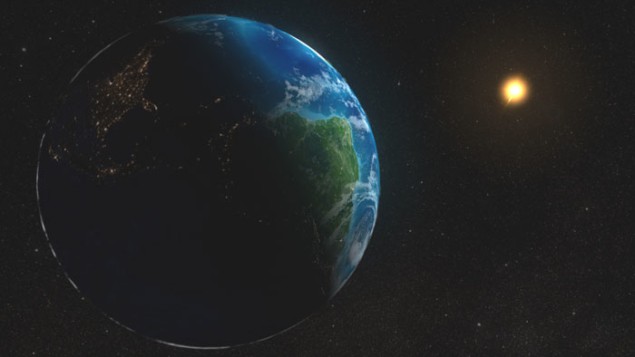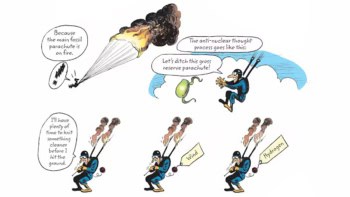
The Earth could be closer than previously thought to the inner edge of the Sun’s habitable zone, according to a new study by planetary scientists in the US and France. The research also suggests that if our planet moved out of the habitable zone, it could lead to a “moist greenhouse” climate that could kick-start further drastic changes to the atmosphere.
A star’s habitable zone is the set of orbits within which a planet could have liquid water on its surface – and being within this zone is considered to be an important prerequisite for the development of life.
The current consensus is that the Sun’s habitable zone begins at about 0.95 astronomical units (AU), a comfortable distance from the Earth’s orbit at 1 AU. However, this latest work by James Kasting and colleagues at Penn State University, NASA and the University of Bordeaux suggests that that inner edge of the zone is much further out at 0.99 AU.
Lost oceans
“Our new climate model predicts that we are closer to the moist-greenhouse scenario than we had thought,” says Kasting. In this scenario, the stratosphere becomes wet and fully saturated as the Earth’s surface warms. This results in the dissociation of water molecules and the release of hydrogen into space. Depending on the levels of atmospheric saturation, the oceans would be completely lost over timescales as long as several billion years. This, say the scientists, would result in our climate changing to resemble a Venus-styled runaway greenhouse.
Penn State’s Ramses Ramirez points out that the atmosphere currently has an average surface relative humidity of 77%, which gradually decreases to 10% or less above an altitude of 10 km – so the atmosphere is far from fully saturated. However, there are two ways that the Earth’s atmosphere could move in that direction.
Slipping over the edge
One is that the Earth’s orbit changes and it slips across the 0.99 AU inner edge. The second is that the Earth remains at 1 AU but rising temperatures caused by greenhouse gases such as water vapour and carbon dioxide lead to a moist greenhouse. Indeed, the researchers are now calculating how much carbon dioxide would be needed for the second scenario to occur.
Scientists believe that a moist greenhouse would begin when the global average temperature reaches 340 K – whereas the current average is 288 K. Kasting says that under really pessimistic assumptions – a 10-fold to 20-fold increase in atmospheric carbon dioxide – it could be possible for the average temperature to reach 340 K. However, he points out that even if humans continue to burn fossil fuels at a very high rate, a catastrophic moist greenhouse would not kick in until at least 2300.
Other researchers, however, point out that the Earth has been much hotter in the past and such a transition did not occur. Dorian Abbot, a climate scientist at the University of Chicago, points out that average temperatures were about 10–15 K warmer during the Cretaceous period. “As far as we know, Earth has never been in a moist-greenhouse state,” says Abbot. “We certainly did not lose our entire oceans.”
Signatures of moist greenhouse by 2100?
Ravi Kopparapu at Penn State says that if current IPCC temperature projections of a 4 K increase by the end of this century are correct – which assumes a rapidly growing and fossil-fuel intensive global economy – our descendants could start seeing the signatures of a moist greenhouse by 2100.
Kopparapu argues that once the atmosphere makes the transition to a moist greenhouse, the only option would be global geoengineering to reverse the process. In such a moist-greenhouse scenario, not only are the ozone layers and ice caps destroyed, but the oceans would begin evaporating into the atmosphere’s upper stratosphere.
Ramirez admits that there are two major caveats associated with the work. The first is the assumption that the modelled atmospheres are already fully saturated. This means that the atmosphere holds as much water vapour as it possibly can at a given temperature. The second is that the models do not incorporate cloud feedback, which could be important.
“Sobering” results
Despite these caveats, Kasting still thinks that the results are sobering. “If you are this close to [the] inner edge of the habitable zone, it is not as difficult to push yourself over…[and] that is catastrophic,” he says.
However, Colin Goldblatt, a planetary scientist at the University of Victoria in Canada, cautions against taking the concept of a habitable zone too literally. “I can put a planet at 0.9 AU and that planet will be perfectly habitable,” says Goldblatt. “It might not be where Kasting would like to retire, but things will live there.”
The research is described in The Astrophysical Journal.



